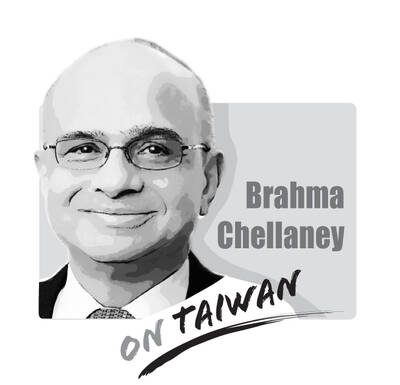The Executive Yuan recently revised a page of its Web site on ethnic groups in Taiwan, replacing the term “Han” (漢族) with “the rest of the population.” The page, which was updated on March 24, describes the composition of Taiwan’s registered households as indigenous (2.5 percent), foreign origin (1.2 percent) and the rest of the population (96.2 percent).
The change was picked up by a social media user and amplified by local media, sparking heated discussion over the weekend. The pan-blue and pro-China camp called it a politically motivated desinicization attempt to obscure the Han Chinese ethnicity of most Taiwanese.
The Executive Yuan said the revision was made on the advice of the Control Yuan.
In 2022, Control Yuan member Hung Yi-chang (鴻義章) said that use of “Han” and “Indigenous” as two broad population groups only serves to highlight the division between the two groups, and is not conducive to eliminating racial discrimination or promoting equality.
Indeed, the term “Han Chinese” is liberally applied to cover most, if not all, non-indigenous groups, in Taiwan, including Hoklo (閩南), Hakka (客家), post-Chinese Civil War migrants, and even Tibetans and Mongolians. Such compulsory inclusion is a reflection of Taiwan’s history of imperialism and authoritarianism.
Taiwanese were subjected to “Sinicization” during the Chinese Qing Dynasty occupation and “Japanization” during the Japanese colonial period from 1895 to 1845. After the Chinese Nationalist Party (KMT) forces retreated to Taiwan, the Republic of China (ROC) government imposed 38 years of martial law. Autocratic measures such as bans on speaking Hoklo and an education system focused on learning the history and geography of China were introduced to force Taiwanese to think of themselves as “Chinese” and consolidate the party’s dominance.
Even today, while foreign residents can register as “foreigners” and indigenous people can register their ethnic status on household registrations, all other Taiwanese are collectively named “Han Chinese.” What is more concerning is this incorrect demographic description has been used by the Chinese communists to falsely claim that Taiwan is part of China.
Studies have shown that most Taiwanese should be considered ethnically distinct from Han Chinese. Decades of research by medical anthropologist Marie Lin (林媽利) indicate that most Taiwanese have mixed bloodlines and genetic markers as descendants of lowland Pingpu (平埔族) and highland indigenous peoples, and are more closely related to Austronesian Aborigines and Pacific islanders, but not allied with the genetic characteristics of the major Han Chinese groups in China.
The revision of the national demographic description is also grounded on evolutionary ethnic definitions under laws such as the Indigenous Peoples Status Act (原住民身分法) and the Household Registration Act (戶籍法). These laws allowing Taiwanese to self-identify with various ethnic origins are all marks of democratization and transitional justice in Taiwan.
Using an umbrella term “Han Chinese” to refer to the vast majority of Taiwanese is inappropriate and counterfactual. On the other hand, referring to the majority as “the rest” is vague and does not do justice to their ethnic origins.
Removing the compulsory stereotyping of Taiwanese as Han Chinese could be a beginning. The government can look to two examples for inspiration — Canadians can self-report their ethnic origins while Australians can nominate up to two ancestries for classification into ancestry groups — and encourage Taiwanese to seek their factual ethnic root and self-identity.
A response to my article (“Invite ‘will-bes,’ not has-beens,” Aug. 12, page 8) mischaracterizes my arguments, as well as a speech by former British prime minister Boris Johnson at the Ketagalan Forum in Taipei early last month. Tseng Yueh-ying (曾月英) in the response (“A misreading of Johnson’s speech,” Aug. 24, page 8) does not dispute that Johnson referred repeatedly to Taiwan as “a segment of the Chinese population,” but asserts that the phrase challenged Beijing by questioning whether parts of “the Chinese population” could be “differently Chinese.” This is essentially a confirmation of Beijing’s “one country, two systems” formulation, which says that
Media said that several pan-blue figures — among them former Chinese Nationalist Party (KMT) chairwoman Hung Hsiu-chu (洪秀柱), former KMT legislator Lee De-wei (李德維), former KMT Central Committee member Vincent Hsu (徐正文), New Party Chairman Wu Cheng-tien (吳成典), former New Party legislator Chou chuan (周荃) and New Party Deputy Secretary-General You Chih-pin (游智彬) — yesterday attended the Chinese Communist Party’s (CCP) military parade commemorating the 80th anniversary of the end of World War II. China’s Xinhua news agency reported that foreign leaders were present alongside Chinese President Xi Jinping (習近平), such as Russian President Vladimir Putin, North Korean leader Kim

Taiwan stands at the epicenter of a seismic shift that will determine the Indo-Pacific’s future security architecture. Whether deterrence prevails or collapses will reverberate far beyond the Taiwan Strait, fundamentally reshaping global power dynamics. The stakes could not be higher. Today, Taipei confronts an unprecedented convergence of threats from an increasingly muscular China that has intensified its multidimensional pressure campaign. Beijing’s strategy is comprehensive: military intimidation, diplomatic isolation, economic coercion, and sophisticated influence operations designed to fracture Taiwan’s democratic society from within. This challenge is magnified by Taiwan’s internal political divisions, which extend to fundamental questions about the island’s identity and future
Taiwan People’s Party (TPP) Chairman Huang Kuo-chang (黃國昌) is expected to be summoned by the Taipei City Police Department after a rally in Taipei on Saturday last week resulted in injuries to eight police officers. The Ministry of the Interior on Sunday said that police had collected evidence of obstruction of public officials and coercion by an estimated 1,000 “disorderly” demonstrators. The rally — led by Huang to mark one year since a raid by Taipei prosecutors on then-TPP chairman and former Taipei mayor Ko Wen-je (柯文哲) — might have contravened the Assembly and Parade Act (集會遊行法), as the organizers had